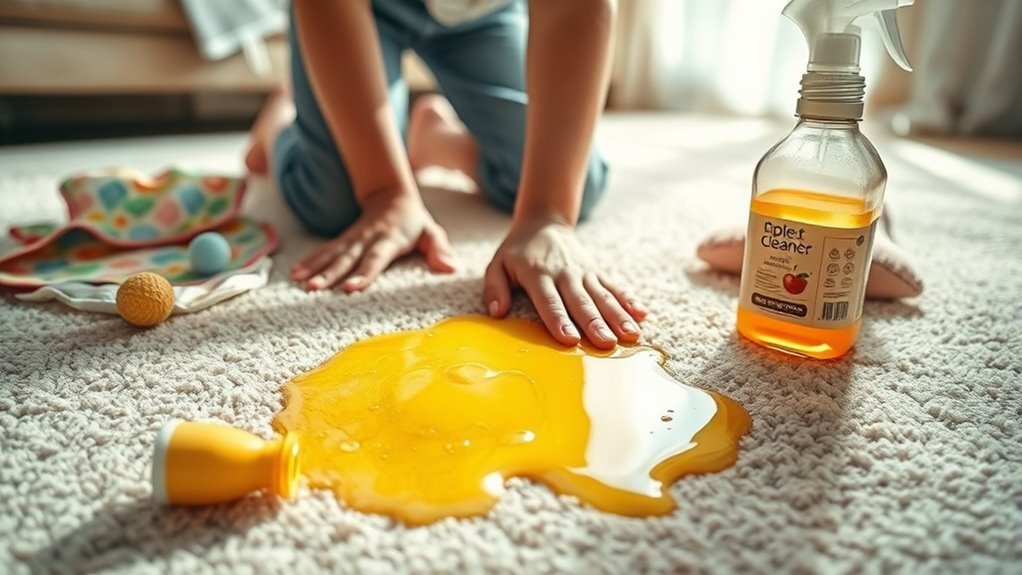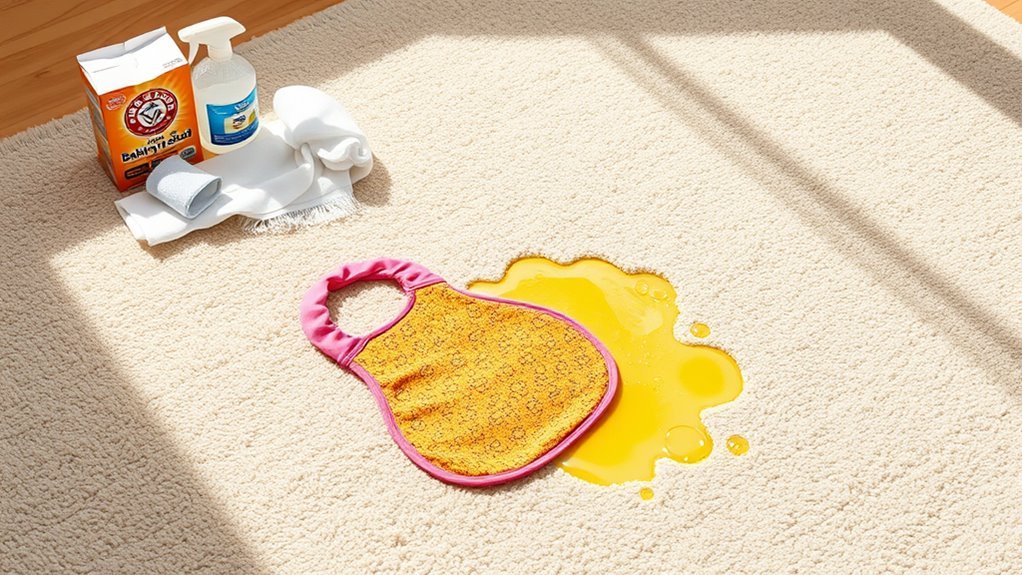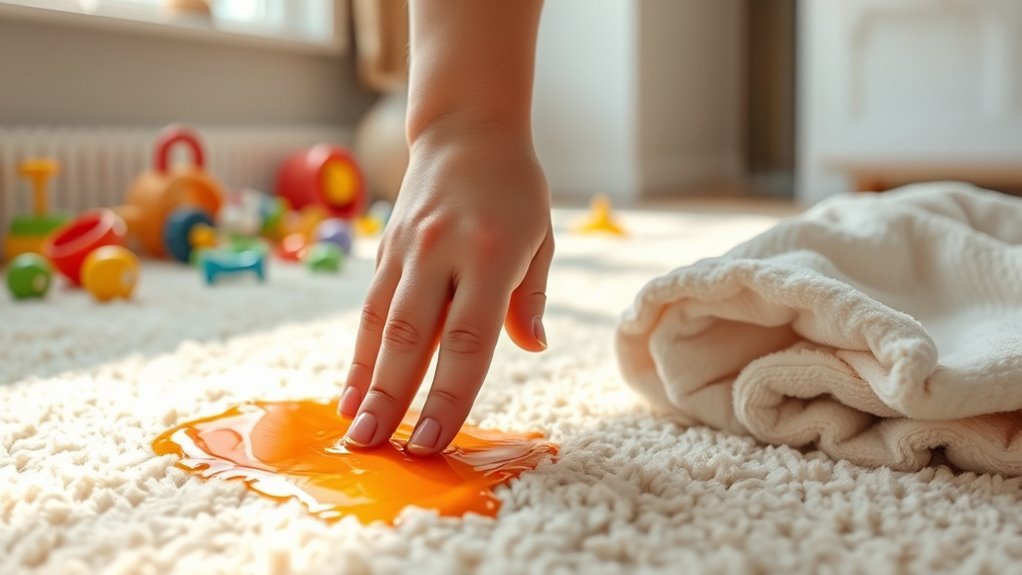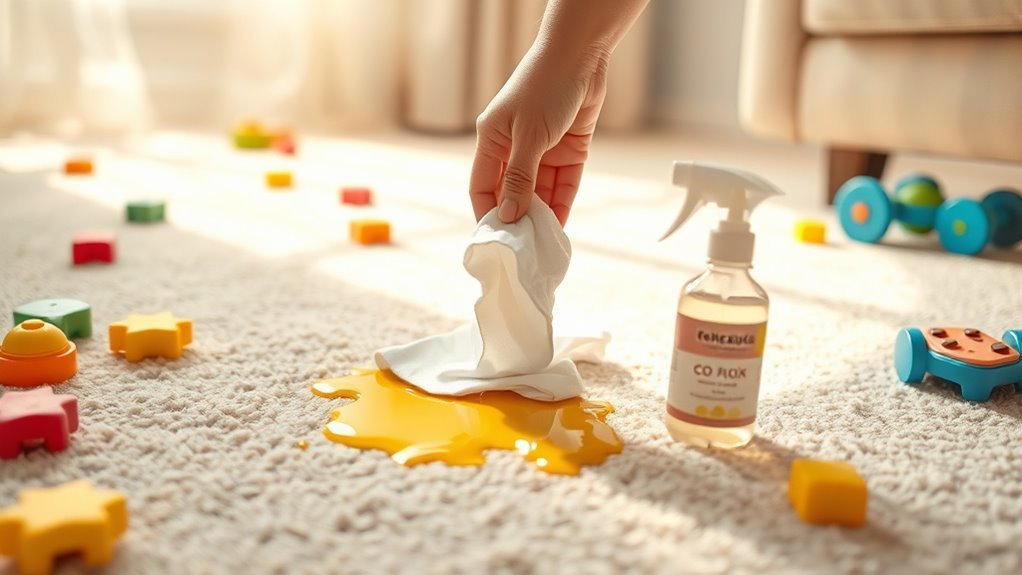Removing Baby Items Stains From Carpets
To remove baby item stains from carpets, act quickly by blotting spills with a clean cloth—never rub. Use cold water to dilute, then apply a mild, baby-safe enzymatic cleaner to neutralize proteins and odors. For formula or milk, avoid hot water to prevent setting. Tougher stains like juice or diaper leaks may require gentle vinegar-water solutions or eco-friendly detergents. Proper drying and vacuuming guarantee freshness. Keep going to discover tailored methods for each stain type and advanced care tips.
Common Types of Baby Stains on Carpets

When dealing with baby stains on carpets, you’ll most commonly encounter substances like milk, urine, vomit, and diaper leaks. Baby spit up, a frequent cause of stains, contains partially digested milk and enzymes that can discolor fibers if not treated promptly. Urine and diaper leaks introduce ammonia and bacteria, which may cause persistent odors and fiber degradation. Vomit, often acidic, can erode carpet dyes and fibers, requiring careful neutralization. Additionally, diaper rash creams, when leaked onto carpets, leave greasy residues that attract dirt and complicate removal. Understanding these stain types helps you select appropriate cleaning agents and methods, ensuring effective stain elimination without damaging carpet integrity. Recognizing the chemical composition behind each stain empowers you to maintain a fresh, hygienic carpet environment that supports your freedom from persistent baby stain issues. Immediate action is crucial since starting the cleaning process within minutes can prevent stains from setting and becoming more difficult to remove, as emphasized in timing for effective stain removal.
Immediate Steps to Take After a Spill
Although spills can happen unexpectedly, acting quickly is essential to prevent stains from setting into your carpet fibers. Your quick action directly impacts stain prevention, preserving your carpet’s integrity. First, gently blot the spill with a clean, white cloth or paper towel—never rub, as that spreads the stain and damages fibers. Next, use cold water to dilute the spill, applying it sparingly to avoid saturation. Then, continue blotting until most of the liquid is absorbed. Finally, place a dry cloth over the area and weigh it down to draw out moisture.
- Blot immediately without rubbing
- Apply cold water to dilute
- Absorb excess liquid thoroughly
- Use pressure to remove moisture
These steps maximize stain prevention and maintain carpet quality. Incorporating natural cleaners can also help disinfect and freshen the carpet without harsh chemicals.
Using Household Products for Stain Removal

Since baby stains often involve organic materials like milk or food, you can effectively tackle them using common household products. Start by sprinkling baking soda directly onto the damp stain; this absorbs moisture and neutralizes odors. Let it sit for 15 minutes, then vacuum thoroughly. Next, mix a solution of one part household vinegar to two parts water in a spray bottle. Lightly spray the stained area, ensuring not to oversaturate the carpet fibers. Vinegar’s mild acidity breaks down organic residues, facilitating removal. Afterward, blot gently with a clean cloth to lift the loosened stain. Avoid rubbing, as this can embed particles deeper. This method offers an accessible, chemical-free approach to stain removal, giving you control over carpet care without relying on harsh commercial cleaners. For best results, wipe up spills immediately to prevent stains from setting deeper into the carpet fibers.
Techniques for Removing Formula and Milk Stains
Building on the use of household products, tackling formula and milk stains requires prompt and targeted action to prevent protein-based residues from setting into carpet fibers. You’ll want to address milk residue and formula buildup quickly to avoid permanent discoloration and odor.
Start by blotting the stain with a clean cloth to absorb excess liquid without rubbing. Then, apply a mixture of cold water and a small amount of enzymatic cleaner to break down proteins effectively. After letting it sit for 10 minutes, blot again to lift the stain.
Key steps include:
- Avoid hot water; it can set protein stains.
- Use enzymatic cleaners designed for dairy stains.
- Blot gently to prevent spreading.
- Rinse with cold water to remove residues.
Promptness and correct technique are essential for freedom from stubborn formula buildup. Understanding different types of carpet stains helps tailor cleaning approaches for better results.
Cleaning Baby Food and Juice Stains Effectively

When you encounter baby food or juice stains on your carpet, first identify the type of stain to choose the appropriate cleaning method. Use safe, non-toxic cleaning solutions designed for delicate fibers to avoid damage. Applying targeted stain removal techniques promptly will increase your chances of complete removal. It is also important to use pet-safe cleaners to ensure the cleaning process is both effective and safe for your family.
Identifying Stain Types
Although baby food and juice stains may seem similar, identifying their specific characteristics is essential for effective removal. Accurate stain identification relies heavily on color analysis and texture assessment. Baby food stains often exhibit a thicker, pasty consistency with varied pigmentation depending on ingredients, whereas juice stains are typically more liquid with uniform coloration. To assist your stain identification, consider these factors:
- Color intensity and hue variations indicating pigment type
- Texture differences signaling solid versus liquid residues
- Stain edges—diffuse for juices, more defined for solid foods
- Time elapsed since staining affecting penetration depth
Safe Cleaning Solutions
Since baby stains vary in composition, selecting safe cleaning solutions that target specific residues without damaging carpet fibers is essential. For baby food and juice stains, you’ll want to use eco friendly cleaners that are both effective and gentle. These cleaners minimize chemical exposure, preserving your carpet’s integrity and promoting a healthier environment. Enzymatic solutions are particularly effective because they break down organic compounds in baby food and juice, ensuring thorough stain removal. When choosing products, verify they’re designed for delicate fibers and free from harsh chemicals like bleach or ammonia. This approach lets you confidently clean without risking fiber damage or lingering residues, maintaining your carpet’s appearance while providing a safe space for your family.
Stain Removal Techniques
Because baby food and juice stains can set quickly, acting promptly is essential to prevent permanent discoloration. To effectively remove these stains, start by blotting excess liquid without rubbing, which could spread the stain. Use stain removal tips like applying a mild detergent solution or a vinegar-water mix to break down sugars and pigments. Rinse with cold water and blot dry. For stubborn stains, a carpet-specific enzymatic cleaner can be very effective. Remember, thorough carpet care means avoiding harsh chemicals that could damage fibers.
Key stain removal tips include:
- Blot, don’t rub, to avoid spreading
- Use gentle, pH-balanced cleaning agents
- Rinse thoroughly to remove residues
- Employ enzymatic cleaners for persistent stains
Following these steps helps maintain your carpet’s appearance and longevity.
Handling Diaper Leak Stains Safely
When you notice a diaper leak stain, act immediately to prevent it from setting into the carpet fibers. Use a safe, enzyme-based cleaning solution designed to break down organic matter without damaging the carpet. Always test the cleaner on a small, inconspicuous area first to guarantee it won’t cause discoloration or fiber degradation. Prompt action and using enzymatic cleaners can help ensure complete stain and odor removal.
Immediate Stain Treatment
Although tackling diaper leak stains might seem intimidating, prompt and careful action can prevent permanent damage to your carpet fibers. Your immediate response is essential for effective stain absorption, limiting the stain’s penetration depth. First, gently blot the affected area without rubbing, which can embed the stain deeper. Use a clean, white cloth or paper towel to absorb excess moisture. Then, apply minimal pressure to avoid spreading the stain further. Remember to work from the outside edge towards the center to contain the leak. Key steps to guarantee effective immediate treatment include:
- Swift blotting to maximize stain absorption
- Avoiding rubbing to protect carpet fibers
- Using neutral-colored cloths to prevent dye transfer
- Working from edges inward to contain the stain
These techniques maintain carpet integrity while preparing for thorough cleaning later.
Safe Cleaning Solutions
After you’ve managed the immediate blotting and containment of the stain, selecting the right cleaning solution is key to safely removing diaper leak residues without damaging your carpet. Opt for eco friendly cleaners specifically formulated for delicate fibers; they minimize chemical exposure while effectively breaking down organic matter. Natural remedies like a mixture of white vinegar and water can neutralize odors and dissolve stains without harsh side effects. Always test any solution in an inconspicuous area first to verify colorfastness. Apply the cleaner gently with a soft cloth or spray bottle, avoiding excessive saturation that could promote mold growth. Rinse the area with cold water and blot dry to prevent residue buildup. By choosing these safe cleaning methods, you maintain your carpet’s integrity while freeing yourself from stubborn baby stain challenges.
Preventing Stains From Setting Into Carpet Fibers
Because stains begin to bond with carpet fibers almost immediately, taking prompt action is essential to prevent permanent damage. To guarantee effective stain prevention and carpet protection, you need to act swiftly and methodically. Begin by blotting the stain with a clean, absorbent cloth—never rub, as this can push the stain deeper. Then, apply an appropriate cleaning solution based on the stain type. Finally, dry the area thoroughly to inhibit mold and residue buildup.
Act quickly by blotting stains, using the right cleaner, and drying thoroughly to protect your carpet.
Key steps to prevent stains from setting include:
- Blot spills immediately with a clean cloth
- Use pH-neutral, baby-safe cleaning agents
- Avoid excessive moisture to prevent fiber damage
- Regularly apply carpet protectors or sealants for barrier reinforcement
Using enzyme cleaners can also help neutralize odors and prevent stains from becoming permanent.
Maintaining Carpet Freshness After Cleaning
When you’ve thoroughly cleaned your carpet, maintaining its freshness requires consistent care and proper techniques to prevent odor buildup and fiber degradation. Start by applying targeted carpet deodorizing techniques such as sprinkling baking soda or using enzymatic sprays specifically designed to neutralize organic odors. Choose freshening solutions that are safe for carpet fibers and free from harsh chemicals to preserve material integrity. Regular vacuuming is essential to remove residual particles and prevent dirt accumulation, which can cause odors. Additionally, guarantee the carpet dries completely after cleaning to inhibit mold and mildew growth. Incorporating these methods into your routine helps sustain a fresh, odor-free environment, extending the lifespan of your carpet while giving you the freedom to enjoy a clean, inviting space without lingering baby stain odors. Using natural deodorizing methods can provide gentle, effective freshening that complements your regular cleaning routine.
Frequently Asked Questions
Can Professional Carpet Cleaning Remove Old Baby Stains?
Ever wondered if stubborn stains are truly conquerable? When it comes to old baby stains, professional carpet cleaning uses advanced stain removal techniques that penetrate deep fibers, often restoring carpets effectively. However, success depends on carpet cleaning frequency—regular maintenance improves outcomes. While some ancient stains may resist total removal, professionals maximize your carpet’s lifespan and appearance, giving you the freedom to enjoy a fresh, clean home without stressing over past messes.
Are There Any Baby-Safe Carpet Cleaning Products Recommended?
If you’re looking for baby-safe carpet cleaning products, natural cleaners are your best bet. These eco friendly options use plant-based enzymes and mild ingredients that effectively break down stains without harsh chemicals, ensuring your baby’s health isn’t compromised. Brands like Biokleen and Seventh Generation offer formulations that are both powerful and gentle. Choosing these products means you’re free to clean confidently, maintaining a safe environment while protecting the carpet’s fibers.
How Do Carpet Materials Affect Stain Removal Effectiveness?
When it comes to stain removal, you know every cloud has a silver lining—carpet fibers play a vital role here. Natural fibers like wool absorb stains more, making removal tougher, while synthetic fibers such as nylon and polyester offer better stain resistance. The denser and tighter the weave, the less chance stains penetrate deep, giving you more freedom to clean effectively. Understanding your carpet’s material helps you choose the right method for best stain removal.
Can Stain Removal Methods Harm Allergy-Sensitive Babies?
You should be cautious when using carpet chemicals, as some can trigger allergy reactions in sensitive babies. Many stain removal agents contain harsh substances that might irritate a baby’s respiratory system or skin. Opt for hypoallergenic, non-toxic products specifically designed to minimize chemical exposure. Always ventilate the area well and test cleaners on a small carpet section. This way, you protect your baby’s health without compromising stain removal effectiveness.
Is Steam Cleaning Safe for Carpets With Baby Stains?
Think of steam cleaning as a precision tool rather than a blunt instrument. Its effectiveness lies in using high-temperature vapor to break down baby stain types like milk, food, and urine without harsh chemicals. This method sanitizes carpets deeply, removing bacteria and allergens while preserving carpet fibers. For you, this means a safe, thorough clean that respects your baby’s sensitivity and your desire for a chemical-free environment, ensuring freedom from worry and stains alike.





